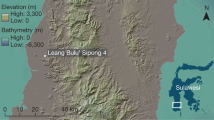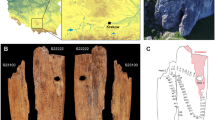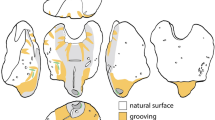Abstract
Archaeologists have always viewed the origin of figurative art as a crucial threshold in human evolution1,2. Here I report the discovery of three figurines carved from mammoth ivory at Hohle Fels Cave in the Swabian Jura of southwestern Germany, which provides new evidence for the appearance of figurative art more than 30,000 years ago. The finds include the oldest known representation of a bird, a therianthropic sculpture and an animal that most closely resembles a horse. The Aurignacian sculptures of the Swabian Jura belong to one of the oldest traditions of figurative art known worldwide and point to the Upper Danube as an important centre of cultural innovation during the early Upper Palaeolithic period3,4.
This is a preview of subscription content, access via your institution
Access options
Subscribe to this journal
Receive 51 print issues and online access
$199.00 per year
only $3.90 per issue
Buy this article
- Purchase on Springer Link
- Instant access to full article PDF
Prices may be subject to local taxes which are calculated during checkout


Similar content being viewed by others
References
Lewis-Williams, D. The Mind in the Cave (Thames and Hudson, London, 2002)
Leroi-Gourhan, A. Préhistoire de l'Art Occidental (Citadelles & Mazenod, Paris, 1995)
Hahn, J. Kraft und Aggression. Die Botschaft der Eiszeitkunst im Aurignacien Süddeutschlands? (Archaeologica Venatoria, Tübingen, 1986)
Conard, N. J. & Bolus, M. Radiocarbon dating the appearance of modern humans and the timing of cultural innovations in Europe: new results and new challenges. J. Hum. Evol. 44, 331–371 (2003)
Voelker, A. H. L., Grootes, P. M., Nadeau, M.-J. & Sarnthein, M. Radiocarbon levels in the Iceland Sea from 25–53 kyr and their link to the earth's magnetic intensity. Radiocarbon 42, 437–452 (2000)
Beck, J. W. et al. Extremely large variations of atmospheric 14C concentration during the Last Glacial period. Science 292, 2453–2458 (2001)
Richter, D., Waiblinger, J., Rink, W. J. & Wagner, G. A. Thermoluminescence, electron spin resonance and 14C-dating of the late Middle Paleolithic and the early Upper Paleolithic site of Geißenklösterle in southern Germany. J. Archaeol. Sci. 27, 71–89 (2000)
Schmid, E. Die altsteinzeitliche Elfenbeinstatuette aus der Höhle Stadel im Hohlenstein bei Asselfingen, Alb-Donau-Kreis. Fundb. Baden Württemb 14, 33–118 (1989)
Münzel, S. C. Cave bear hunting in the Swabian Alb (Germany), 30,000 years ago. Abhandl. Karst- und Höhlenkunde 34, 36–39 (2002)
Riek, G. Die Eizeitjägerstation am Vogelherd im Lonetal I. (Heine, Tübingen, 1934)
Porr, M. in Eiszeitkunst im Süddeutsch-Schweizerischen Jura (eds Müller-Beck, H., Conard, N. J. & Schürle, W.) 95–102 (Theiss, Stuttgart, 2001)
Vogelsang, R. Middle-Stone-Age-Fundstellen in Südwest-Namibia (Heinrich Barth Institut, Cologne, 1998)
Broglio, A. Paleolithico e Mesolitico. Preistoria Veronese 5, 11–56 (2002)
Fortea, J. Los comienzos del arte paleolítico en Asturias: aportaciones desde una arqueología contextual no postestilística. Zephyrus 53, 177–216 (2001)
Pettitt, P. & Bahn, P. Current problems in dating Palaeolithic cave art: Candamo and Chauvet. Antiquity 77, 134–141 (2003)
Neugebauer-Maresch, C. Zum Neufund einer weiblichen Statuette bei den Rettungsgrabungen an der Aurignacien-Station Stratzing/Krems-Rehberg, Niederösterreich. Germania 67, 551–559 (1989)
Clottes, J. (ed.) La Grotte Chauvet: L'Art des Origines (Seuil, Paris, 2001)
Valladas, H. & Clottes, J. Style, Chauvet and radiocarbon. Antiquity 77, 142–145 (2003)
Züchner, C. La cueva Chauvet, datada arqueológicamente. Edades Revista Historia 6, 167–185 (1999)
Churchill, S. E. & Smith, F. H. Makers of the Early Aurignacian of Europe. Yearb. Phys. Anthropol. 43, 61–115 (2001)
Conard, N. J., Langguth, K. & Uerpmann, H-P. Einmalige Funde aus dem Aurignacien und erste Belege für ein Mittelpaläolithikum im Hohle Fels bei Schelklingen, Alb-Donau-Kreis. Archäol. Ausgr. Baden Württemb. 21–27 (2003)
Dansgaard, W. et al. Evidence for general instability of past climate from 250-kyr ice-core record. Nature 364, 218–220 (1993)
Stuiver, M. & Grootes, P. M. GISP2 oxygen isotope ratios. Quatern. Res. 53, 277–284 (2000)
Hahn, J. Aurignacien. Das ältere Jungpaläolithikum in Mittel- und Osteuropa (Böhlau, Cologne, 1977)
Bon, F. L'Aurignacien entre Mer et Océan: Réflexion sur l'Unité des Phases Anciennes de l'Aurignacien dans le Sud de la France Mémoire 29 (Soc. Préhist, Franc, 2002)
Acknowledgements
Many colleagues working on the Palaeolithic archaeology and palaeoecology of the Swabian Jura have contributed to this research, including but not limited to M. Bolus, H. Floss, P. Goldberg, H. Jensen, A. Kandel, P. Krönneck, K. Langguth, M. Malina, U. Müller, S. Münzel, L. Niven, D. Richter, F. Smith, H.-P. Uerpmann and K. Wehrberger. I thank M. Collard for comments. This research has been supported by the Deutsche Forschungsgemeinschaft, the University of Tübingen, the Landesdenkmalamt Baden-Württemberg, the Alb-Donau-Kreis, Heidelberger Cement, the Museumsgesellschaft Schelklingen and the Gesellschaft für Urgeschichte.
Author information
Authors and Affiliations
Corresponding author
Ethics declarations
Competing interests
The author declares that he has no competing financial interests.
Rights and permissions
About this article
Cite this article
Conard, N. Palaeolithic ivory sculptures from southwestern Germany and the origins of figurative art. Nature 426, 830–832 (2003). https://doi.org/10.1038/nature02186
Received:
Accepted:
Issue Date:
DOI: https://doi.org/10.1038/nature02186
This article is cited by
-
A 36,200-year-old carving from Grotte des Gorges, Amange, Jura, France
Scientific Reports (2023)
-
First direct evidence of lion hunting and the early use of a lion pelt by Neanderthals
Scientific Reports (2023)
-
Subsistence of early anatomically modern humans in Europe as evidenced in the Protoaurignacian occupations of Fumane Cave, Italy
Scientific Reports (2023)
-
The Quaternary lions of Ukraine and a trend of decreasing size in Panthera spelaea
Journal of Mammalian Evolution (2023)
-
What about Apatite? Possibilities and Limitations of Recognising Bone Mineral Residues on Stone Tools
Journal of Paleolithic Archaeology (2022)
Comments
By submitting a comment you agree to abide by our Terms and Community Guidelines. If you find something abusive or that does not comply with our terms or guidelines please flag it as inappropriate.



